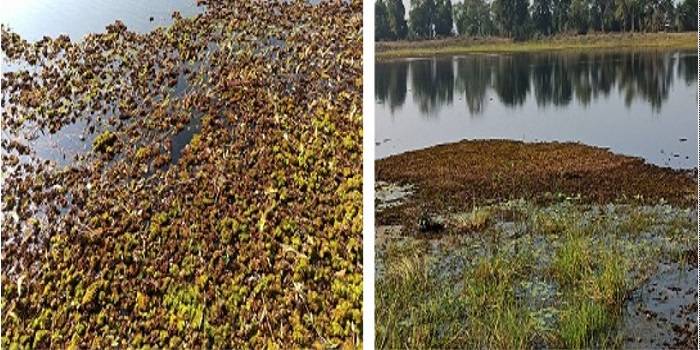
The Salvinia molesta, commonly known as “Water Fern” is an aggressive and a fast growing Alien Invasive Aquatic Weed of the South-Eastern Brazil origin. During the past 60 Years, it has been spread widely throughout the world and recently added on to the list of the World’s 100 Most Invasive Weed Species.
Earlier, it was reported as problematic aquatic weed in Kerala and the other parts of South India, besides the stray occurrence in Odisha, Uttarakhand and Maharashtra. Recently, the Weed’s severe infestation was found in Satpura Reservoir in Sarni Town of Betul and 3 to 4 Villages of Jabalpur and Katni Districts of Madhya Pradesh adversely affecting the irrigation, hydroelectric generation, water availability and navigation besides drastic reduction in production of fish and aquatic crops (chestnut).
Effect of Water Fern in Central & North India:
The Weed may turn out to be a menace in the aquatic bodies of the Central and North India. The non-availability of the label-claim herbicides for aquatic weed management, water quality deterioration, environmental pollution, high cost of mechanical removal, regeneration of Weeds after removal, etc., are the major challenges for its management.
The manual removal is only practical in the early stages of invasion. After the plant becomes established, the biomass of about 80 Tonnes/ha and rapid re-growth makes mechanical harvesting and removal impractical and not cost-competitive. Therefore, the biological control was considered to be an eco-friendly and cost-effective method for its management.
A host-specific insect namely Cyrtobagous saliviniae is known to be an effective bio-agent against Salvinia molesta in Kerala. Initially, the insect was collected from Thrissur, Kerala where it was released earlier during the 1980. The initial culture was brought to the ICAR-Directorate of Weed Research, Jabalpur, Madhya Pradesh for testing its bio-efficacy and further multiplication.
The Study revealed that the insect bio-agent may be effective for controlling the Weed in spite of very low and high temperature variation under the climatic conditions of Central India. For demonstrating the technology, a 20 hectare Salvinia infested pond in the village Padua of Katni District was selected for the release of the bio-agent in consultation with the Villagers and Sarpanch. The pond was found to be severely infested for the last 3 Years and all the efforts of manual removal by the Villagers were in vain.
Initially, 2,000 adult weevils of host/specific bio-agent Cyrtobagous saliviniae were released in the infested pond in the Month of December, 2019.
After releasing the bio-agent, it started multiplying in the pond gradually. Initially, upto 6 Months, there were no visible symptoms of the attack, but the gradual increase in insect population was recorded. The bio-agent population increased from negligible to 125.5 adults per metre square in 11 Months and started to decline in the due course with the decrease in population density of the Weed.
With the increase of bio-agent population, 50%, 80% and 100% control of Salvinia molesta was achieved by 8, 11 and 18 Months, respectively. The insect kills the Weed by feeding on the terminal buds and new growth, while its larvae tunnel through buds and rhizomes. The killing of the terminal buds checks the re-growth of the Weed.
The Cyrtobagous salviniae population declines corresponding to the decline in the Weed density. The decline eventually comes to a low-level equilibrium between the Weed and insect population.
There was no regeneration of Weed from a few scattered remnants of Salvinia molesta. This is the first successful example of biological control of the Alien Invasive Aquatic Weed from Central India.
Although the technology takes time, it is very effective, sustainable and cheap for the management of Salvinia molesta.
Source: ICAR
















